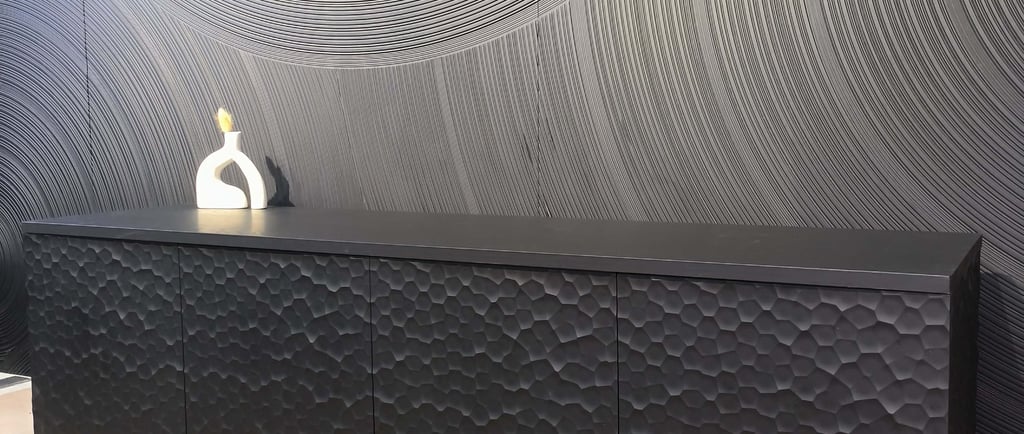Why Textured 3D Boards Are Transforming Modern Interior Design
Interior design is no longer just about color and furniture selection. In today's evolving design landscape, materials that offer both aesthetic and tactile appeal are gaining unprecedented attention.
AnheFurniture
1/30/20233 min read


Introduction
Interior design is no longer just about color and furniture selection. In today's evolving design landscape, materials that offer both aesthetic and tactile appeal are gaining unprecedented attention. One such material is the textured 3D board. These intricately CNC-engraved panels bring a dynamic visual effect and palpable texture to spaces, making them a favorite among designers, architects, and furniture makers.
What Are Textured 3D Boards?
Textured 3D boards are wood-based panels—typically made from MDF (Medium Density Fiberboard) or plywood—that are carved with unique patterns using CNC (Computer Numerical Control) machines. The result is a raised, three-dimensional surface texture that can be used across a range of applications: from walls to wardrobe doors, from cabinetry to table surfaces.
The Rise of Tactile Surfaces in Modern Interiors
For years, interior surfaces were flat and purely visual. Today’s designers are exploring new ways to engage the sense of touch. Textured 3D boards fulfill this need by adding physical depth and visual intrigue to otherwise plain surfaces. In minimalist interiors, these panels act as focal points. In contemporary commercial settings, they express creativity and craftsmanship.
Advantages of Using Textured 3D Boards
Visual Impact – Textured 3D boards create light and shadow effects, offering movement and dynamism to static surfaces.
Customizability – Whether it’s a wave pattern, geometric form, or an abstract design, CNC technology enables limitless custom design possibilities.
Material Versatility – Available in MDF or plywood core, textured 3D boards can be adapted for various structural and aesthetic requirements.
Finish Options – These boards can be painted, veneered, or laminated, allowing them to match any interior style.
Easy Integration – Whether it’s part of a cabinet face or wall cladding, textured boards are easily integrated into interior designs.
Applications of Textured 3D Boards in Interior Design
Feature Walls: One of the most popular uses of textured 3D boards is as accent walls. In lobbies, bedrooms, or dining areas, these panels add an upscale feel without needing extra decor.
Furniture Panels: Cabinet doors, wardrobe fronts, and drawer faces can all feature textured 3D boards to bring uniqueness to everyday furniture.
Ceiling Treatments: Designers are now applying 3D boards to ceilings to create depth and acoustical interest.
Retail Displays and Commercial Interiors: In stores or offices, textured boards can reinforce brand identity and add sophistication.
Popular Textures and Patterns
Wave Lines – Organic and calming, ideal for spas or bedrooms.
Geometric Patterns – Sharp lines and symmetrical forms suit modern commercial spaces.
Random Grooves – Abstract and artistic, great for creative studios or custom furniture.
Nature-Inspired Motifs – Leaves, branches, or stone effects fit well in eco-friendly designs.
Material Options: MDF vs. Plywood Core
MDF Core: Offers a smooth, uniform texture, perfect for detailed CNC engraving. More affordable and commonly used for indoor applications.
Plywood Core: Stronger and more moisture-resistant, suitable for areas with higher structural demands or humidity.
Case Study: Transforming a Boutique Hotel Lobby
A boutique hotel in Southeast Asia partnered with Anhe Furniture to redesign their lobby area using textured 3D boards. With a combination of wave and geometric patterns across the front desk and lounge walls, the space was transformed into a visually striking, tactile experience. The CNC-engraved panels were painted in soft metallic tones, elevating the perceived luxury of the space.
Sustainability and Eco-Friendliness
Textured 3D boards can be produced from FSC-certified MDF or plywood, ensuring responsible forestry practices. Additionally, these panels reduce the need for decorative overlays or wall hangings, minimizing the use of additional materials.
Maintenance and Durability
Textured 3D boards are easy to maintain. A simple dusting or occasional wipe with a damp cloth keeps them clean. When properly sealed or finished, they resist warping, fading, and surface wear.
Why Designers Love Textured 3D Boards
They add personality to plain surfaces.
Offer a strong return on aesthetic investment.
Provide a tactile experience in an increasingly digital world.
Match well with lighting features to enhance shadows and highlights.
Future Trends in Textured Panel Design
As CNC technology evolves, we can expect more complex patterns, finer engravings, and even multi-depth 3D carving. Additionally, new materials and finishes—such as metallic coatings or acoustic backings—are likely to expand application possibilities.
Conclusion
Textured 3D boards are no longer a novelty—they are fast becoming a design essential. At Anhe Furniture, we specialize in crafting high-quality textured 3D boards tailored for residential, commercial, and hospitality projects. Whether you're an interior designer seeking a signature wall, a contractor looking for reliable finishes, or a hotel developer aiming to stand out, textured 3D boards offer an unmatched combination of form and function.
Ready to explore more? Contact us today to discover how textured 3D boards can redefine your next project.


